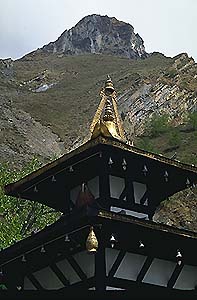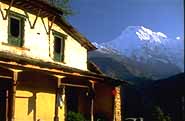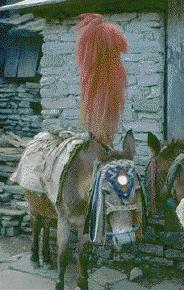The Long Way Down
My first luxury in quite a while, apart from getting rid of the
altitude sickness, was a tiny bowl of popcorn. Mona Lisa Guesthouse in
Muktinath had this on the menu, and I was totally fascinated by the
concept. It was somewhere around 50 popped corns, and they cost about
the same as one night's accommodation there. Together with the apples
they grow there, that made Muktinath seem like Heaven to me.
Incidentally, Muktinath is fairly close to Heaven, according to
Hinduism and Buddhism. The holy temple of Lord Muktinath is an
important place of pilgrimage for followers of these two
religions. What makes this place so special is to me the amazing
quality of the apples, but pilgrims come here to see the place where
you can find fertile soil, springs of boiling water and an eternal
flame from methane gas coming out of the heavenly Himalayas. The
pilgrims seemed mainly to consist of two groups: 1)Indians who devotes a
part of their life to walk from their local village up here, wash
their feet and walk quite happily back down again. 2) Japanese
hobby-buddhists, on a weekend package holiday, going by plane to
Jomsom and doing the rest of the trip sitting on a donkey,
photographing Muktinath from all angles, complaining about the rice
and getting out of there as fast as possible. I don't know what to say
about the place. To be honest, the spring, the fire and the temple
wasn't impressive in any other way than being 3769 meters above sea
level.
 As a sharp contrast to all this holiness is the local chapter of Hell's
Angels. They don't have large Harley Davidsons, but they certainly are
horsepowered. The Japanese customers have created a huge market for
horses, and when the boys in the hood aren't out transporting
pilgrims, they race the horses back and forth in the street,
uhm... it's more like a path, actually, of Muktinath. Apart from
making the path all muddy, this is their way of impressing the local
young, unmarried women of the village. It works very well, there were
many children to be seen everywhere. Another rather unholy thing are
all the guesthouses, in particular the Bob Marley Bar, where they play
reggae only, for both the two hours of electricity they have each
day. It's just about enough electricity so that I could charge my
electrical shaver again. I think my perfect shave each and every
morning must annoy the other trekkers, who most often choose to let
the hair in their face grow while they're in the wilderness. Oh well.
As a sharp contrast to all this holiness is the local chapter of Hell's
Angels. They don't have large Harley Davidsons, but they certainly are
horsepowered. The Japanese customers have created a huge market for
horses, and when the boys in the hood aren't out transporting
pilgrims, they race the horses back and forth in the street,
uhm... it's more like a path, actually, of Muktinath. Apart from
making the path all muddy, this is their way of impressing the local
young, unmarried women of the village. It works very well, there were
many children to be seen everywhere. Another rather unholy thing are
all the guesthouses, in particular the Bob Marley Bar, where they play
reggae only, for both the two hours of electricity they have each
day. It's just about enough electricity so that I could charge my
electrical shaver again. I think my perfect shave each and every
morning must annoy the other trekkers, who most often choose to let
the hair in their face grow while they're in the wilderness. Oh well.
Due to tired feet and heavy rain, I spent a day resting in Muktinat,
before leaving with Yvonne and Esther from the Netherlands. My feet
definitely were in a Dutch-walking mood. The walk between Muktinath
and Jomsom is possible the most beautiful one on the whole
circuit. There are huge, open, barren plateaus with deep canyons and
beautifully rounded mountains with lots of caverns. I expected to see
Djengis Khan and a thousand riders coming against me at every turn.
We had lunch at Hill Ton Hotel in Yekle Bhatti. Hot
chocolate. Yummy. The trek from Muktinath and down is called the Apple
Pie Trek because of all the uhm... non-exotic cafes and bakeries on
the way. This particular one had very interesting signs:
We have Delicious eatable things, everything you need,
chocolet and flim!
From there to Jomsom the we were able to walk fairly fast, as we were
following a rather dry, 300m wide river, which must be a very
impressive sight when it's filled with water. I suspect that the
winters in Jomsom are very cold, as all the roofs in the village are
covered with firewood. Either that, or they have a huge
burn-down-the-village party every once in a while. There is a bank in
Jomsom, Nepal Bank Limited, and everything else was rather
limited as well. This was due to there having been bad weather for
some days, so there had been no airplanes arriving with new goods.
 This also meant there were a lot of tourists in town, not being able
to fly out. So, most of the guesthouses were full. Still, we managed
to find a brand new guesthouse, Lomanthang Guest House, paying 185
rupis for three beds. And we were just about the only people there.
The reason was that they hadn't made the roof waterproof yet, so after
last night's rain, everything was wet. We turned the beds around in
strange angles to find a place where it wasn't dripping on them and
slept very well. Oh, and there were no electricity, so the showers were
short and cold, but still exactly what I needed, somehow.
This also meant there were a lot of tourists in town, not being able
to fly out. So, most of the guesthouses were full. Still, we managed
to find a brand new guesthouse, Lomanthang Guest House, paying 185
rupis for three beds. And we were just about the only people there.
The reason was that they hadn't made the roof waterproof yet, so after
last night's rain, everything was wet. We turned the beds around in
strange angles to find a place where it wasn't dripping on them and
slept very well. Oh, and there were no electricity, so the showers were
short and cold, but still exactly what I needed, somehow.
The next day we covered almost 20 kilometres, getting to Koketani, a tiny
village close to Kalopani. Actually, we thought it WAS Kalopani until after
we had settled in a guest house there. We took the wrong turn somewhere.
Yes, there are very few signposts in Himalaya. It was a nice place, but a
proof that this place wasn't on the main trek route could be found in the
chocolate they sold; It was so old it had turned green.
As everywhere else, the surrounding mountains were stunning,
during the day's walk we could see Dhaulagiri (8167m), Tukuche (6920m),
Nilgiri (6940m) and some of the Annapurna peaks (about 8000m). But the
banks of the river weren't a pretty sight. For several reasons, erosion
is moving a lot of soil down the rivers continuosly. The path goes on the
edge of more ground ready to fall into the river, and many places we had to
climb a bit, to get past landslides of varying sizes. We walked past a
lot of revegetation project fields, but most of them were already in the
middle of the river or obviously destroyed in other ways.
 The next day I left the Dutch, as they wanted to slow down a bit and wait
for some German friends. This meant I walked far that day, guided and pushed
forwards by all the good things I'd heard about my destination: Tatopani.
More and more often I was met by horse/donkey caravans, bringing supplies
up into the mountains. Not everything is carried by horses. Actually, I
think most is carried by men. Especially large items, like panels and
boards for housebuilding are carried on their backs, with a strap over their
forehead. It looks impossible, but it isn't.
The next day I left the Dutch, as they wanted to slow down a bit and wait
for some German friends. This meant I walked far that day, guided and pushed
forwards by all the good things I'd heard about my destination: Tatopani.
More and more often I was met by horse/donkey caravans, bringing supplies
up into the mountains. Not everything is carried by horses. Actually, I
think most is carried by men. Especially large items, like panels and
boards for housebuilding are carried on their backs, with a strap over their
forehead. It looks impossible, but it isn't.
The villages from Kalopani and down were of a different standard than the
ones I had seen earlier on my trek. They seemed much more developed, the
houses had glass windows and they even had roads covered with flat stones.
In Ghasa I was told I could get to Tatopani in about 5 hours of walking.
I decided that I would not go to bed without eating something with meat
that day, and so I had to get to Tatopani. Three and a half hours later I
was there, and got the last available room in the village at Namaste Hotel,
at 60 rupi per night. It was a very nice room. It had walls going almost to
the floor and the ceiling, and there were just a few holes into the room
next to it. The best thing about it was the view, as I could see straight
into the common shower from my window.
The feeling I had, coming to Tatopani was a bit like the feeling I had a
couple of years later, when I arrived in New York City after some days
in Iceland. All of a sudden there was so many manmade things to see. There
was electricity, 24 hours a day, infinite amounts of running water, even
hot water if you were willing to pay. Coca Cola signs. A laundry shop
(no machines, though). And the room was just about as clean as the hostel
I stayed in in New York City. #:D) But most important, I got chicken for
dinner. KaliGandaki Fried Chicken was just about the best chicken I had had
in a loooong time. Well, of course it wasn't, but after more than 2 meatless
weeks, it certainly felt great.
I had now come close to the end of my trek in the Himalayas, but there
were a lot of adventures waiting for me further on.
bct@pvv.org
Last modified: Sun Jul 20 21:29:41 MET DST 1997
 As a sharp contrast to all this holiness is the local chapter of Hell's
Angels. They don't have large Harley Davidsons, but they certainly are
horsepowered. The Japanese customers have created a huge market for
horses, and when the boys in the hood aren't out transporting
pilgrims, they race the horses back and forth in the street,
uhm... it's more like a path, actually, of Muktinath. Apart from
making the path all muddy, this is their way of impressing the local
young, unmarried women of the village. It works very well, there were
many children to be seen everywhere. Another rather unholy thing are
all the guesthouses, in particular the Bob Marley Bar, where they play
reggae only, for both the two hours of electricity they have each
day. It's just about enough electricity so that I could charge my
electrical shaver again. I think my perfect shave each and every
morning must annoy the other trekkers, who most often choose to let
the hair in their face grow while they're in the wilderness. Oh well.
As a sharp contrast to all this holiness is the local chapter of Hell's
Angels. They don't have large Harley Davidsons, but they certainly are
horsepowered. The Japanese customers have created a huge market for
horses, and when the boys in the hood aren't out transporting
pilgrims, they race the horses back and forth in the street,
uhm... it's more like a path, actually, of Muktinath. Apart from
making the path all muddy, this is their way of impressing the local
young, unmarried women of the village. It works very well, there were
many children to be seen everywhere. Another rather unholy thing are
all the guesthouses, in particular the Bob Marley Bar, where they play
reggae only, for both the two hours of electricity they have each
day. It's just about enough electricity so that I could charge my
electrical shaver again. I think my perfect shave each and every
morning must annoy the other trekkers, who most often choose to let
the hair in their face grow while they're in the wilderness. Oh well.
 This also meant there were a lot of tourists in town, not being able
to fly out. So, most of the guesthouses were full. Still, we managed
to find a brand new guesthouse, Lomanthang Guest House, paying 185
rupis for three beds. And we were just about the only people there.
The reason was that they hadn't made the roof waterproof yet, so after
last night's rain, everything was wet. We turned the beds around in
strange angles to find a place where it wasn't dripping on them and
slept very well. Oh, and there were no electricity, so the showers were
short and cold, but still exactly what I needed, somehow.
This also meant there were a lot of tourists in town, not being able
to fly out. So, most of the guesthouses were full. Still, we managed
to find a brand new guesthouse, Lomanthang Guest House, paying 185
rupis for three beds. And we were just about the only people there.
The reason was that they hadn't made the roof waterproof yet, so after
last night's rain, everything was wet. We turned the beds around in
strange angles to find a place where it wasn't dripping on them and
slept very well. Oh, and there were no electricity, so the showers were
short and cold, but still exactly what I needed, somehow.
 The next day I left the Dutch, as they wanted to slow down a bit and wait
for some German friends. This meant I walked far that day, guided and pushed
forwards by all the good things I'd heard about my destination: Tatopani.
More and more often I was met by horse/donkey caravans, bringing supplies
up into the mountains. Not everything is carried by horses. Actually, I
think most is carried by men. Especially large items, like panels and
boards for housebuilding are carried on their backs, with a strap over their
forehead. It looks impossible, but it isn't.
The next day I left the Dutch, as they wanted to slow down a bit and wait
for some German friends. This meant I walked far that day, guided and pushed
forwards by all the good things I'd heard about my destination: Tatopani.
More and more often I was met by horse/donkey caravans, bringing supplies
up into the mountains. Not everything is carried by horses. Actually, I
think most is carried by men. Especially large items, like panels and
boards for housebuilding are carried on their backs, with a strap over their
forehead. It looks impossible, but it isn't.